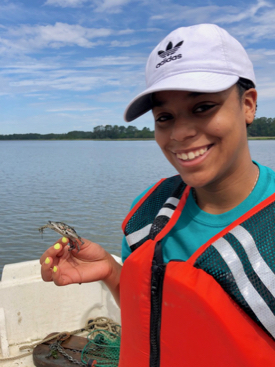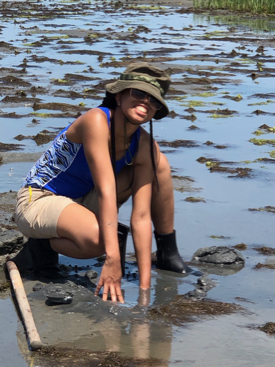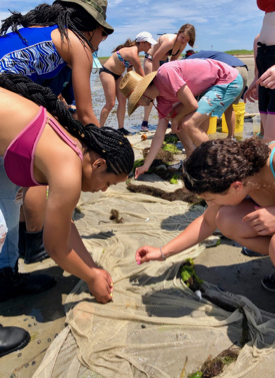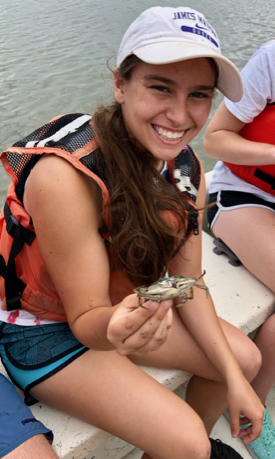REU program celebrates 30th anniversary at VIMS
Undergrads from across U.S. conduct studies in field and lab
Undergraduates from across the nation spent 10 weeks in the field and laboratory this summer during the 30th annual “Research Experiences for Undergraduates” program at William & Mary’s Virginia Institute of Marine Science.
The 13 interns in this year’s “REU” program at VIMS were Brittany Baker (Oakland University), Josephine Hall (Univ. of Arkansas), Magaleate Kostelnik (Univ. of Tampa), Anna Bi Ledwin (William & Mary), Chanté Lively (Nova Southeastern Univ.), Mary McGuiness (New Jersey Inst. of Technology), Sarah Monica (Vanderbilt Univ.), Coral O’Brien (Virginia State Univ.), Kayla Rutherford (James Madison Univ.), Jacob Wacht (W&M), Thalia Wallace (Community College of Philadelphia), and Tobi Yañez (Univ. of Virginia). Nicholas Coleman (Coastal Carolina Univ.) also participated with funding from the Chesapeake Research Consortium.
Base funding for the REU program at VIMS and other research centers is provided by the National Science Foundation. Additional funding for the VIMS program comes from W&M, private donors, and grants to individual faculty.
“REU programs introduce students to inquiry-based research, provide mentoring and role models, and offer an opportunity to increase diversity in the geosciences,” says Dr. Rochelle Seitz, research professor and REU director at VIMS. Helping her administer the 2019 program were Program Coordinator Jennifer Dreyer and Teaching Assistant Katherine Longmire.
 Seitz says VIMS’ REU program—which began in 1989—is one of the longest-running and most successful in the nation. “Of the 173 interns who participated in our program between 1997 and 2015,” she notes, “69% are pursuing or have completed master’s or PhD degrees in ocean science or a related field. Some have authored research publications with their VIMS mentors, and several have come to VIMS for graduate school, including a handful on campus today.”
Seitz says VIMS’ REU program—which began in 1989—is one of the longest-running and most successful in the nation. “Of the 173 interns who participated in our program between 1997 and 2015,” she notes, “69% are pursuing or have completed master’s or PhD degrees in ocean science or a related field. Some have authored research publications with their VIMS mentors, and several have come to VIMS for graduate school, including a handful on campus today.”
Seitz says a highlight of this year’s experience was “seeing the look on Thalia Wallace’s face when she held a blue crab for the first time—sheer joy and exhilaration.” She adds, “The students not only aid in our research, but their enthusiasm reminds us why we enjoy our jobs.”
Wallace, a rising sophomore at the Community College of Philadelphia, studied red-spot disease and antibiotic resistance in American eels, under the mentorship of VIMS Ph.D. student Aman Kohli and Associate Professor Andrew Wargo.
A broad spectrum of undergraduate research
The REU students at VIMS tackled scientific questions in areas spanning the broad spectrum of research at VIMS.
Brittany Baker, a rising senior at Oakland University in Rochester, Michigan, worked with technician Ellen Biesack and faculty advisors Jan McDowell and David Rudders to better understand the feeding ecology of sea scallops using DNA barcoding. “I’m bringing microbiology and genetics knowledge back to Oakland University,” says Baker, and “would recommend the REU program to other undergrads because of the sense of community at VIMS and the informative seminars.” She says the highlight of her REU experience was seeing the juvenile sandbar sharks at VIMS’ Eastern Shore Laboratory.
Josephine Hall, a rising junior at the University of Arkansas, studied with marine scientist Gabby Saluta and Professor Rom Lipcius how different bottom types affect spat settlement and oyster-reef restoration in the Chesapeake Bay. She particularly enjoyed field work. “Whether it was for the Juvenile Crab Survey on the Eastern Shore, the Oyster Survey on the Lafayette and York rivers, or right off the beach behind Andrews Hall,” she says, “we always had great experiences.”
“This internship taught me a lot about working in a research lab,” Hall adds. “I was involved with multiple grad students, technicians, and managers, allowing me to learn how to coordinate plans and troubleshoot with a large group.”
Anna Ledwin, a rising junior at William & Mary, partnered with Ph.D. student Serina Wittyngham and Assistant Professor David Johnson to explore the factors that drive herbivory in local salt marshes. “I really enjoyed getting to know the other REUs and the members of my lab,” she says.  “This experience taught me that the people you work with are just as important as the work you're doing, and that life is much more fun and productive when you like who you're working with. I also better understand how a lab operates and the day-to-day doings of a scientist. I had a fabulous summer with my mentors and learned more about the direction I want to take my career.”
“This experience taught me that the people you work with are just as important as the work you're doing, and that life is much more fun and productive when you like who you're working with. I also better understand how a lab operates and the day-to-day doings of a scientist. I had a fabulous summer with my mentors and learned more about the direction I want to take my career.”
Chanté Lively, a rising junior at Nova Southeastern University, joined with Longmire and Seitz to investigate how the salinity and pH of seawater might affect the structure and composition of a blue crab’s cuticle. She says “The program was a memorable experience for me. I very much enjoyed the VIMS community and the ability to help out in multiple projects… Everyone was very helpful and had great advice for my many questions. In regards to the other interns, I loved meeting people who are as passionate about marine science as I am.”
“Florida isn’t known for blue crabs, clams, or oysters,” Lively adds. “One thing I’ll be spreading to my home institution is my knowledge of those organisms and the research and conservation efforts of VIMS.”
 Coral O’Brien, a rising sophomore at Virginia State University, explored interactions between Vibrio bacteria and local phytoplankton species under the mentorship of Associate Research Scientist Corinne Audemard and Professor Kim Reece. She says the highlight of her REU experience “was the all the people I worked with in the lab, as well as fellow REU interns. The lesson I’m taking back to my home institution is how to operate a PCR machine and gel electrophoresis.”
Coral O’Brien, a rising sophomore at Virginia State University, explored interactions between Vibrio bacteria and local phytoplankton species under the mentorship of Associate Research Scientist Corinne Audemard and Professor Kim Reece. She says the highlight of her REU experience “was the all the people I worked with in the lab, as well as fellow REU interns. The lesson I’m taking back to my home institution is how to operate a PCR machine and gel electrophoresis.”
O’Brien says she would “absolutely recommend the REU program for any undergraduate. It’s a good opportunity to figure out if research is what you want to do in the future, while making life-long friends.”
Other participants in the 2019 REU session at VIMS studied everything from computer modeling to microplastics:
- Nicolas Coleman (CCU) assessed the quality of nursery habitats for black sea bass and summer flounder, partnering with Lab & Research Specialist Shannon Smith, Dr. Troy Tuckey, and Professor Mary Fabrizio.
- Magaleate Kostelnik (Univ. of Tampa) looked at how pH and temperature affect oyster larvae, under the mentorship of Master’s student Annie Schatz and Assistant Professor Emily Rivest.
- Mary McGuinness (NJ IT) characterized the metabolism of bottom-dwelling invertebrates in the York River, working with Ph.D. students Derek Detweiler and Michelle Woods, and Professor Iris Anderson.
- Sarah Monica (Vanderbilt) analyzed how oyster orient themselves with respect to water flow under the supervision of marine scientist Gabby Saluta and Professor Rom Lipcius.
- Kayla Rutherford (JMU) modeled sediment erosion with Associate Professor Grace Chiu.
- Jacob Wacht (W&M) partnered with Postdoctoral Research Associate Linlin Cui and Professor Courtney Harris to model the dynamics of bottom waters in the Gulf of Mexico “dead zone.”
- Tobi Yañez (UVA) analyzed microplastics in the James and York rivers with Master’s student Samantha Fortin and Associate Professor Bongkeun Song.
 A number of the 2019 REU students come from groups underrepresented in marine science. “A key component of our REU program,” says Seitz, “involves actively recruiting talented students from a range of groups, with under-represented minorities at 37% of participants between 1992 and 2015. These students increase the diversity of our campus, and bring a wealth of experiences and perspectives from across the country and from different cultural backgrounds.”
A number of the 2019 REU students come from groups underrepresented in marine science. “A key component of our REU program,” says Seitz, “involves actively recruiting talented students from a range of groups, with under-represented minorities at 37% of participants between 1992 and 2015. These students increase the diversity of our campus, and bring a wealth of experiences and perspectives from across the country and from different cultural backgrounds.”


